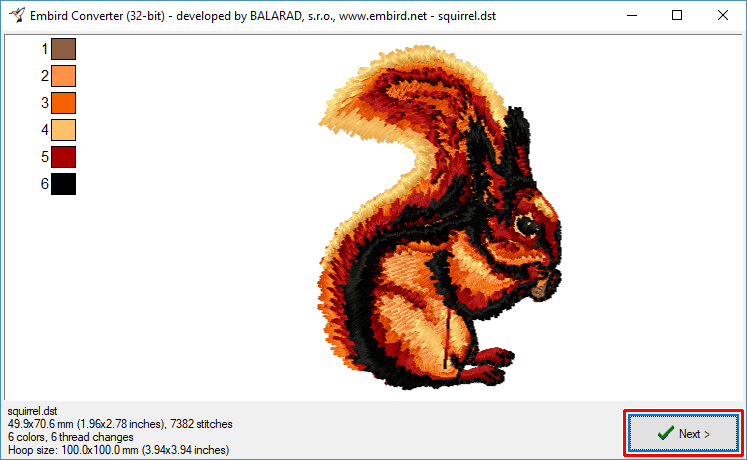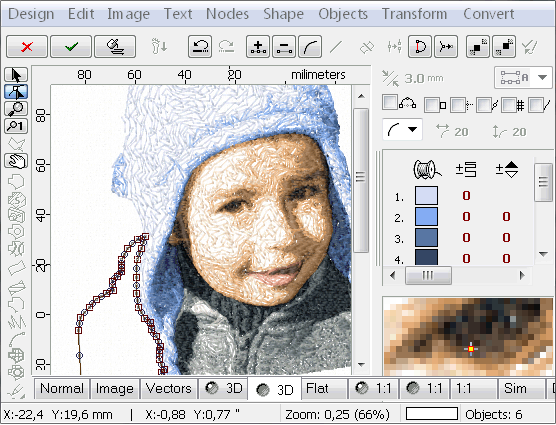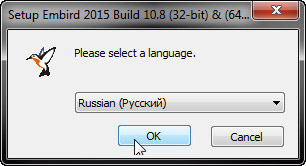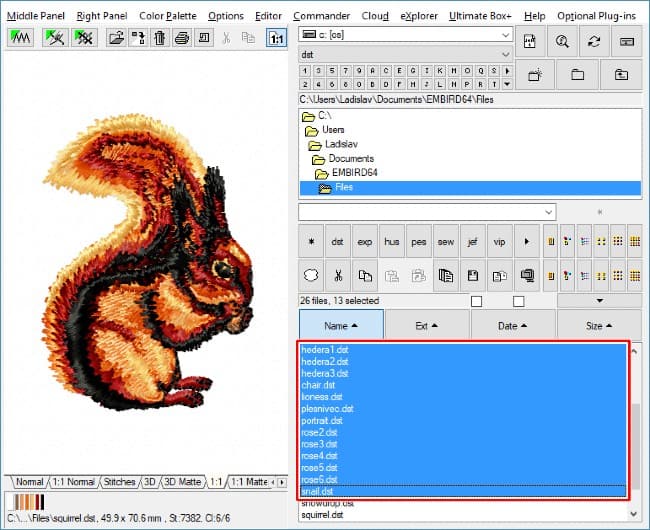

While in Studio, design is in outline format that resizes with much higher quality than stitch files in Editor. Specific Rules of Digitizing with Embird Studio There are also some rules specific for the Embird Studio: Do all resizing of designs digitized in Studio directly in Studio, not in Embird Editor.

Neighboring areas should overlap one another slightly to prevent gaps caused by pull effect of thread. Underlay should be used only for objects that are large enough to hide the underlay stitches. Edge underlay for broad objects and center-walk underlay for thin objects helps to avoid edge distortion on elastic fabric. When doing complex design, digitize it from center out if possible, to prevent fabric puckering. Design for elastic fabric needs more pull compensation. Use pull compensation to prolong the stitches. Thread tension always causes the real stitches to be a little bit shorter than how they look on the screen. Use Fill object without cover stitches for this purpose. When making design composed of several neighboring areas, it is useful to make zig-zag underlay under whole design first, to stabilize the fabric. Good designs have as few color changes and trims as possible. The order of objects in an embroidery design is very important to minimize number of jumps and color changes. Remember to use connections to connect objects with running stitch paths. General Rules of Embroidery Digitizing To make embroidery design that looks good and sews out smoothly, follow these general rules: Create objects so that jumps occur only where you want to have them.

Compilation involves generation of stitches for all vector objects, including those that were not filled with stitches by user. The finished design is compiled and put into Embird Editor for final adjustment and save in appropriate embroidery format. There are also special t menu/ Help.ģ Get Started Designs (patterns) are digitized in Studio as outline (vector) objects with stitches layout based on the object type and parameters. Vector objects can be easily resized, because stitches can be re-generated. Wh produc e stitch files ready for saving in appropriate file format Vector object (left) filled with stitches (right). Vector files generated by Studio are kind of "source files". Moreover, objects in embroidery design should be c low number of trims as possible. There is a big difference between embroidery desig difference is that order of objects and their overlapping is mu graphics. Tools available in Studio are very programs. Fortunately, most objects in design can be filled with more or sufficient to draw vector outlines of the object and fill it with s color in a graphic program. However, creation of design with stitch-by-stitch method would be very tedious and time consuming process. Stitch files contain coordinates of each stitch and some color and trim commands. Stitch files are the end product of embroidery software, because stitch files are used by embroidery machines as a list of commands to produce embroidery. Therefore, Studio uses other tools than the basic Embird program. Basic Concept - Vector Objects While basic Embird program works mostly with stitch files, Studio uses vector objects for easier creation of design. Sfumato stitches form meanders of variable density to approximate the underlying picture while leaving the fabric show through. Sfumato uses similar vector objects like the Digitizing Tools, but they are filled with different type of stitches.

It can be combined with Digitizing Tools to add lettering, borders, etc. Sfumato Stitch allows user to create photo-realistic designs from digital images. All these approaches can be combined one with another. Vector objects are created manually node-by-node, with free-hand or trace tool and from vector graphic files (EMF, WMF, CMX). Vector objects are then filled with stitches. Design is digitized so that user creates outline (vector) objects either on a blank background or on an image used as a template. Digitizing Tools serve to fancy designs, lettering and company logos digitizing. Both Sfumato and Digitizing Tools parts are optional, which means that it is not necessary to purchase them both. Studio contains two parts: Sfumato Stitch and Digitizing Tools. It allows user to digitize her/his own, custom designs. Ģ Embird Studio Digitizing Tools (optional part) Sfumato Stitch (optional part) Optional Parts Embird Studio is an additional plug-in for Embird, available in a separate installation file. 1 Digitizing Tools Sfumato Stitch (C) BALARAD, s.r.o.


 0 kommentar(er)
0 kommentar(er)
